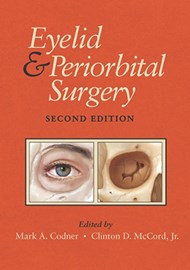Many specialities in surgery intersect, allowing for clinical and research collaboration. Plastic surgery and ophthalmology are one such example wherein a number of different principles have been combined in order to develop reconstructive techniques for conditions affecting the orbital soft tissues including its appendages.
The second edition of Eyelid and Periorbital Surgery is an easily readable operative textbook which addresses many aspects of oculoplastic surgery. The book consists of two volumes, organised into five key parts, each with multiple chapters. Each chapter has the same format – starting with an overview of the key points being discussed and ending with a succinct conclusion and bibliography.
Part one on ‘Fundamentals’ discusses periorbital anatomy and physiology and includes an insightful chapter on the principles of skin grafts and local flaps which can be used for periorbital reconstruction. Parts two and three focus on periorbital aesthetics, with each part presenting surgical and non-surgical treatments, respectively. The chapters covering the different surgical techniques for aesthetic surgery provide superb clinical photographs and illustrations, which provide a visual aid to help the reader consolidate their understanding of the procedures being described. Furthermore, there are several useful chapters discussing correction of common complications. The non-surgical aesthetic part gives a useful insight into the use of alternative therapies, such as fillers, botox, fat grafting, peels and laser therapy, for periorbital rejuvenation, supplemented with helpful illustrated technique sections.
Part four covers reconstructive surgery, focusing largely on eyelid and periorbital tumours as well as chapters on ptosis repair, Graves' eye disease, common paediatric eyelid anomalies and facial palsy associated ocular impairment. Finally, part five includes the management of acute orbital trauma, globe injury and chapters on lacrimal surgery. I found this up-to-date factual book to be well-written and relatively concise. It amply fulfils the editors’ intent “to stimulate and motivate surgeons to expand their practices to include the eyelids and periorbital areas . . . increase their comfort zone… and improve their ability to help a broader range of patients with confidence.”
Its easy readability will make it both appealing and useful for students, trainees and experts. As a junior trainee I know I will consult it on a regular basis, especially prior to performing a particular oculoplastic procedure and also as a useful adjunct when revising for the FRCS examination. Finally, the inclusion of access to an online video library with this book highlights the editors’ emphasis on providing a range of practical resources for the reader.




